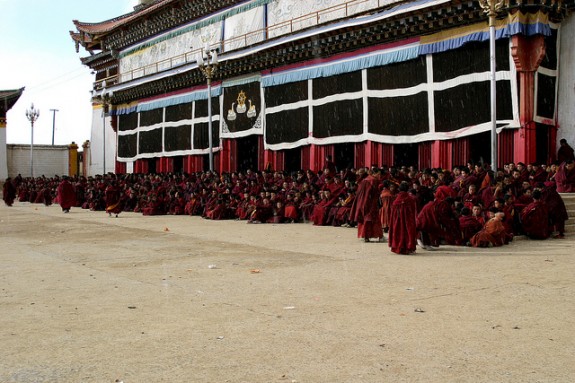Why Have So Many of Tibet’s Monks Set Themselves on Fire?
More than 100 Tibetan monks have set themselves aflame in the past four years

Many of the self-sacrificing monks have come from the Kirti Monastery in China’s Sicuan Province. Photo: Committee of 100 for Tibet
In the Nepalese capital Kathmandu yesterday, says the Associated Press, a 21 year-old Tibetan monk set himself alight inside a café. (Warning: that last link leads to some disturbing images.) Hours later, says Voice of America, the man died in the hospital with burns covering his body. The still-unidentified monk’s display comes just over a week after a similar event, says the CBC: in early February, a 37-year-old former monk also set fire to his own body outside a police station in Tibet. According to advocacy groups, says the New York Times, more than 100 Tibetan monks have set themselves aflame since 2009, the demonstrations intended as a protest of China’s control of Tibet.
“The wave of self-immolations in Tibet, which began in 2009, has brought into sharp relief the intense frustration and defiance of Tibetans, whose vast homeland came under Communist rule after Chinese troops occupied central Tibet in 1951. At least 82 of the 100 self-immolators have died.
… “There has been clear evidence from at least some of the immolators themselves that they have acted as they have in order to demonstrate resistance to Chinese rule,” said Elliot Sperling, a scholar of Tibet at Indiana University.
“Many Tibetans in China accuse the government of religious repression and eroding their culture,” says Agence France-Presse, “as the country’s majority Han ethnic group increasingly moves into historically Tibetan areas.”
The string of self-immolations, says the Atlantic, has drawn international attention to the on-going protests in the region. That attention, writes Lois Farrow Parshley, has resulted in a crackdown by Chinese officials on suspected dissidents.
While China has had a presence in for the past 60 years, its codification of restrictions against traditional Tibetan practices are relatively new. Since a wave of demonstrations embarrassed the Chinese leadership around the time of the Beijing Olympics in 2008, when hundreds of Tibetans protested Chinese rule, prefecture-level regulations have been rolled out in breath-taking detail. While many of these regulations appear harmless or even positive, in aggregate they make for something darker. New “social security measures,” for example, ostensibly provide small cash stipends to monks as an old age benefit. But the pay-outs are contingent on meeting a state-regulated standard of patriotism. As part of this new “good behavior” allowance, the Chinese government has informed Tibet’s monks they will have no need to perform the religious services they used to be paid for. The price of being “supported” by the state, in this instance, is the effective prohibition of their religion.
Turning to self-immolation has a relatively long history in modern times, says the CBC, tracing back to Buddhist monk Thich Quang Duc‘s 1963 protest against then-president of South Vietnam, Jean Baptiste Ngô Đình Diệm.
Aside from garnering international attention, the demonstrations haven’t seemed to have had any effects within the region. The official response to the string of suicides, says the CBC, “consists of a propaganda campaign accusing the exiled Tibetan spiritual leader, the Dalai Lama, of instigating the protest, as well as ever-tighter security measures, including harsh prison sentences for those accused of abetting the suicides, or trying to stop police from seizing the remains.”
More from Smithsonian.com:
Murder in Tibet’s High Places
The World’s Happiest Man Is a Tibetan Monk
Glimpses of the Lost World of Alchi
/https://tf-cmsv2-smithsonianmag-media.s3.amazonaws.com/accounts/headshot/smartnews-colin-schultz-240.jpg)
/https://tf-cmsv2-smithsonianmag-media.s3.amazonaws.com/accounts/headshot/smartnews-colin-schultz-240.jpg)